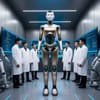China is aggressively developing AI-powered humanoid robots, with government-backed initiatives aiming for mass production by 2025 and global leadership by 2027. The Ministry of Industry and Information Technology has outlined goals to advance robotics technology, including breakthroughs in key areas like brain, cerebellum and limbs.
The country's humanoid robot output has surged 51.5% with state funding exceeding $20 billion. Companies like UBTech and Unitree are leading the charge, developing robots capable of performing complex tasks. These robots are being deployed in various sectors, including manufacturing, logistics, elderly care and urban management.
China's dominance in hardware supply chains, producing up to 90% of components domestically, enables rapid cost reductions and competitive advantages over foreign rivals. The government is establishing massive funds to bolster startups in critical areas like AI and robotics, with cities like Shenzhen and Wuhan offering significant subsidies and support.
The deployment of humanoid robots is expected to transform industries, improve productivity and address demographic challenges. However, concerns about job displacement persist, with experts warning that AI and robotics could impact up to 70% of the manufacturing sector. To mitigate this, lawmakers are discussing AI-specific unemployment insurance and other measures.¹ ² ³
China's humanoid robot industry is poised for significant growth, driven by government support, technological advancements and strategic investments. As the country continues to push the boundaries of AI and robotics, it's likely to have a profound impact on the global economy and society.


